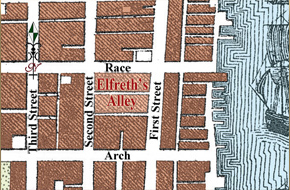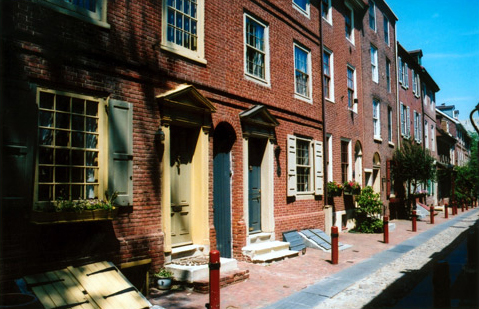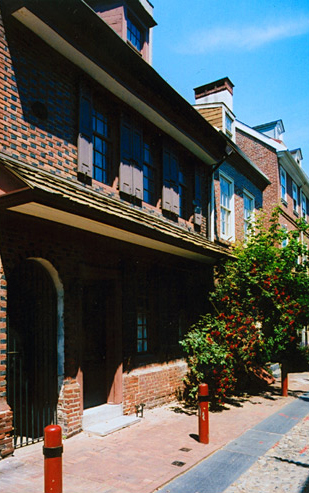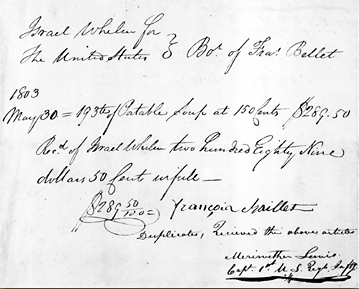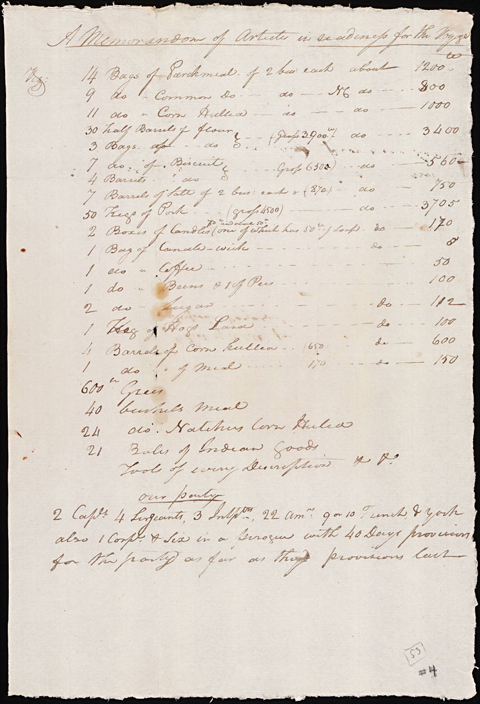The original shopping list that Meriwether Lewis compiled sometime in the winter or spring of 1803 contained more than 180 items, including various “Mathematical Instruments” for navigational purposes, plus arms and accouterments, ammunition, clothing, camp equipage, provisions and means of subsistence, Indian presents, medicine, and packing materials.[1]Jackson, Letters, 1:69-75.
Meriwether Lewis very probably traveled Elfreth’s Alley and streets like it on shopping trips to his suppliers. Though it has been in continuous occupancy longer than any other residential street in America, it was the kind of narrow lane reminiscent of crowded London that William Penn had hoped to avoid in the broad streets of his “greene Country Towne.” Almost from the beginning, the need for workplaces and modest city dwellings close to the waterfront sliced into the original block plan.
A little over a block from Christ Church, the street now known as Elfreth’s Alley began about 1702 with a building owned by Arthur Wells, a blacksmith, and John Gilbert. Today it bears the name of a later property owner, a prosperous blacksmith named Jeremiah Elfreth. An alley was a narrow passage or walkway, whereas streets such as those pictured in William Birch’s engravings were, by definition, wide enough to accommodate horse-drawn wagons and carriages. Elfreth’s Alley connects Front Street with Second Street between Arch Street and Race Street.
A quaint, quiet byway today, it was, when Lewis trod its cobblestones, bustling with the workings, comings and goings of artisans, tradespeople and, since the port was but a block away, sailors and sea-captains. Many of the houses were one room wide and three rooms high, with a kitchen in the basement, a living room on the ground floor, and a bedroom upstairs.
—C. F. Reed
Today the 33 homes lining both sides of Elfreth’s Alley constitute the oldest continually occupied residential street in America.
One of the more stylish homes in Elfreth’s Alley, with its brick facade in Flemish bond style (compare George Logan‘s “Stenton”).
Among the supplies and provisions purchased for Captain Lewis in the spring of 1803 by Israel Whelan, the Purveyor of Public Supplies, was 193 pounds of portable soup made in Philadelphia by a cook named François Baillet,[2]Donald Jackson, Letters of the Lewis and Clark Expedition with Related Documents, 1783-1854 (2 vols, Urbana: University of Illinois Press, 1978), 1:81. at a cost of $289.50. In the 1750s the British Navy had begun issuing 50 pounds of portable soup for every 100 sailors on long voyages, partly to vary the daily diet of salt-cured meats, and partly in the mistaken belief that it would prevent scurvy.[3]Meryl Rutz, “Salt Horse and Ship’s Biscuit: A Short Essay on the Diet of the Royal Navy Seaman During the American Revolution,” … Continue reading It was also widely used as a supplement and an emergency ration during the Revolutionary Era.
Lewis obviously thought of it as a victual of last resort. He issued it to the men for the first time on 14 September 1805 at Killed Colt Camp, and for the last time at “Portable Soup Camp” on the nineteenth. By the twentieth they had, according to Whitehouse, only “a little” of it left. During those six days the 33 adults must have consumed nearly a pound of it per day per person, in a very thick concoction.
There had been hungry days before the Bitterroot crossing, and there were more before they got back to St. Louis, but portable soup was never mentioned again, except as part of the medical treatment of a sick Nez Perce chief.
Lewis’s Shopping List
Invoices for purchases from private vendors in Philadelphia, made in his behalf by Israel Whelan, the Purveyor of Public Supplies for the Army, came to more than 260 separate items.[4]Ibid., 1:79-82. The “Recapitulation of Purchases by The Purveyor for Capt. Lewis” totaled some 200 items.[5]Ibid., 1:93-99. They came from twenty Philadelphia merchants, War Department and Public Stores at the Philadelphia Arsenal (then a mile southwest of the State House (today’s Independence Hall); now two miles inside the southwest boundary of the city), the armory at Harpers Ferry, West Virginia, from Tennessee, and the Public Store at Schuylkill Arsenal west of Philadelphia, which was also the shipping point for all supplies and equipment.
- Coats, stockings, shirts, etc., for 15 men, from Benjamin Mifflin, 22 N.8th Street.
- Fishing tackle for $25.37, including 2,800 fishhooks, from George R. Lawton, 18 Dock Street.
- Tin Horns, lamps, lanterns and cannisters, from Thomas Passmore, N. 7th Street.
- Tomahawks, $19.62, from Nicodemus Lloyd, 6th and Race Streets.
- Fifty-two lead cannisters for powder which, when empty, could be melted into bullets, from George Ludlam, plumber, 96 South Second Street.
- Forty-two medicines, plus cannisters, bottles, chest, Indian ink, and gum elastic, from Gillaspy & Strong, 103 South Second Street.
- Portable soup–193 pounds of it–packed in cannisters, for $289.60, from François Baillet, cook, 21 N. 9th Street. At $1.50 per pound this was the most expensive single item in the expedition’s inventory, reflecting Lewis’s own appreciation of its value, probably having relied on it during his earlier wilderness travels as a military paymaster. He even asked General William Irvine, the superintendent of military stores at Schuylkill Arsenal, for his personal assistance in finding as much as he wanted.[6]Stephen E. Ambrose, Undaunted Courage: Meriwether Lewis, Thomas Jefferson, and the Opening of the American West (New York: Simon & Schuster, 1996), 86.
- Dry goods (a trunkfull), including yards of nonsopretty, from Wm. Chancellor & Co., 259 Market Street.
- Surveying and navigating equipment: levels, surveyor’s compass, a quadrant or octant, a sextant, two-pole surveyor’s chain, and log line, reel, and ship from Thomas Whitney, mathematical instrument maker, 110 South Front Street.
- Wire, needles, awls, thimbles, scissors, drawing knives, vises, pliers, chisels, adzes, handsaws, augers, whetstone, brads, steel tapes, from Harvey & Worth, 62 North Front Street.
- Corn mills, gold scales, iron weights, scissors, large shears, from Edward Shoemaker & Co., 301 Market Street.
- One hundred thirty rolls (63 lb.) of pigtail tobacco, from Thomas Leiper, 726 Market Street
- Fourteen brass kettles, pieces of brass, and a tin saucepan, from Benjamin Haberson & Sons, coppersmiths, 223 Market Street.[7]Lewis’s original estimate of kettle requirements, based on the assumption the expeditionary force would number just fifteen men, included “6 Copper kettles (1 of 5 Gallons, 1 of 3, 2 of … Continue reading
- Scarlet cloth (22 yards), fancy handkerchiefs, and beads, from Jonathan and Charles Wister, 309 Market Street.
- Colored beads (73.5 dozen), small mirrors, burning glasses, pin cases, earrings, tapes and ribbons, tassels and small bells, from Christian H. Denchla, 114 North Third Street.
- Gunpowder (176 lbs.) from Beck & Harvey, 11/12/15 South Water Street–sealed in lead canisters that when empty were melted down into bullets.
- Five hundred broaches and 72 rings from Samuel Williamson, gold- and silversmith, 310 South Front Street.
- Gold chronometer for $250 from Thomas Parker, clock and watchmaker, 31 South Third Street. Henry Voigt, a coiner at the U.S. Mint, adjusted the chronometer, as well as a watch of Jefferson’s.
- Thirty gallons strong wine, in 6 iron-bound kegs from David Jackson, 38 South Third Street.
- Vermillion and red lead from Samuel Wetherill & Son, 65 North Front Street.
- Painted chest for carrying instruments from William Broome, 40 North Fourth Street.
- Fifteen each, rifle pouches and powder horns from Robert C. Martin, Fifth and Market Streets.
- Linen sheeting, grommets, hooks-and-eyes, etc. made into eight tents and 45 cloth bags by Richard Wevill, 167 South Eighth Street.
- Pocket pistols with secret triggers (1 pr.) at $10, from Robert Barnhill, 63 North Second Street
- Twenty-eight yards of fine milled drab cloth plus large and small buttons to make 16 coatees for a total of $246.63, from Francis Brown, Walnut above Eighth Street.
- Forty-eight calico ruffled shirts and 45 flannel shirts with linen collars and wristbands, made by seamstress Matilda Chapman, whose address was not recorded.
- Thirty-five packing boxes from Joseph Thompson.
- Six and one-half dozen jews harps.
- Two lbs. of Hyson tea from Priscilla Logan, presumably for the use of the officers only. Although Hyson is now considered a medium-grade tea, it was so popular in the 18th century that the British Tea Tax was higher on it than on other varieties. Hyson is a Chinese word that means “Flourishing Spring.”
- A branding iron bearing Capt. Lewis’s name and with an open bordered area to be filled in with numbers or other identifiers, for marking boxes and barrels. There is no record of where or when he got it, but it may have been crafted at Harpers Ferry. It was probably not used for branding horses, because it was faster for the men and easier on the horses to use the bottom of a saddle stirrup. Nor was it likely used for marking trees to document their passage; that graffiti was usually carved on the fly with knives or tomahawks.
Supplies from Public Stores
Supplies drawn from Public Stores, for which there were no charges to Lewis’s account, were listed in an invoice dated 18 May 1803. Most were drawn from “Arms and Ammunition” stores; others came from “Camp” and “Clothing” supplies; and one from “Ind[ian] P[resents].”
15 Powder Horns |
36 Pair Stockings |
St. Louis Purchases
At the outset Lewis was shopping for a 15-man expeditionary force, as originally authorized by Congress. By the time he and William Clark reached the site of their winter encampment on the River Dubois in the Illinois country, they had more volunteer soldiers than originally had been planned for, and also saw they would have to hire quite a few civilian hands to get their three boats up the Missouri River to the Knife River Villages (the best market for those personnel was St. Charles). They purchased more supplies in St. Louis, although precisely what and how much is not known. On 16 January 1804, for instance, Clark “settled with the Contractor” for “750 rats. [rations] of Soap Candles & vinager,” with scribbled additions that included a file for sharpening the whipsaw (not listed anywhere, but evidently used–at least at Camp Dubois–to cut planks for the huts), and some whisky. On the 29th Clark received from Lewis, who was in St. Louis, “Some Durant,” or durance, a thick felted woolen cloth made to imitate the soft velvet nap of buff leather. Clark left no clue as to what it might have been used for, but buff leather was frequently made into belts and straps.[8]Buff-leather was a tough, whitish-yellow, fuzzy surfaced leather made of oil-dressed hides of bison or oxen, frequently used during the 18th and early 19th centuries by the U.S. Army for belts and … Continue reading
According to Clark’s journal for 25 March, Pvt. Willard “brought in 10 pr Hinges,” but no source is named. On that same day the men supplemented their rations with “great quantities of honey” they found in nearby natural beehives; we are not told exactly how much, nor how long it lasted.[9]Honey bees, not native to North American, were introduced by early European settlers in the East. The species, Apis mellifera, steadily advanced westward with EuroAmerican settlements. More provisions arrived on 1 pril, but no specifics survive.
On the 14th Clark sent Pvt. Reed to St. Louis with some “Locks to be mended”–probably padlocks, although not listed elsewhere. Clark compiled a final pre-departure inventory of provisions and supplies on hand a few days before the Corps left Camp Dubois for points west.
Undocumented Purchases
There were also items that did not appear in any of the lists, but of which there is evidence they had and used, such as tools for making rope. There was at least one tool that was carried of which no use was ever recorded in the journals, the two cooper’s howels. Each of the captains brought personal items, including their dress uniforms, which all officers had to purchase for themselves. Clark’s was a Corps of Artillerists uniform; Lewis’s was in infantry officers’ colors. Lewis evidently brought along his personal telescope, as well as the repeating air gun that he may have bought in Philadelphia or Pittsburgh.
At Camp Dubois on 21 May 1804, Elijah G. Galusha, “Contractor for various articles of provisions, including transportation,” was paid $1,703.53 for:
|
1351 Compl. Rations from 16 Decr 1803 to 31 Jany. 1804, @ 14 5/10 Cents |
195.89 |
Captain Clark’s Memorandum
To see read the list, point to the image.
Beinecke Rare Book and Manuscripts Library, Yale University
Captain Clark compiled this list of foods, candles, and presents for Indians in the spring of 1804, a few days prior to the Corps’ departure from Camp Dubois on 14 May 1804. It is difficult to reconcile some of the descriptions with the figures in the last column, headed “w” for weight. The abbreviation “bus” stands for bushels. “Viz.” is the Latin abbreviation for “as follows.” Clark’s reference to four sergeants in “Our party” may be merely an error; officially, there were only three.
More lists of provisions appear in Clark’s journals for 14 April 1805 and 15 April 1805; their relationship with the above is not clear. Clearly, however, Clark already had enough provisions to enable him to share some with the Kickapoos, and on 24 March 1804 to give twenty-four Sauks “75 lb Beef, 25 lb flour, & 50 lb meal.”
Fort Mandan Inventory
By the time they were ready to leave Fort Mandan in early April 1805, baling invoices listed 14 bags and one box of Indian presents, including five intended for “foreign Nations: that is those beyond the mandanes,” plus seven bales and one box of “necessary Stores.” Except for materiel they cached at the mouth of the Marias River, above and below the Great Falls of the Missouri, and at Camp Fortunate, that was all they had with them when they set out toward the Pacific. It was the last inventory they took time to write down.[11]One more list appears in Clark’s journal for 7 December 1805, the day the whole party was reunited at the place Lewis had selected for Fort Clatsop, their winter encampment. It consists of the … Continue reading
Letter of Credit
There was one more item in Lewis’s personal baggage that Jefferson had provided to help insure the expedition’s survival, since, as the President observed, “it is to be expected that you will encounter considerable dangers from the Indian inhabitants.”[12]Jackson., Letters1:105-06. It was a letter of general credit to be used to purchase passage by sea from the mouth of the Columbia, via any ship they might chance to encounter there, as well as to obtain cash, clothes, and other necessities, in the event hostile Indians prevented their return overland. Thanks largely to the friendship and generosity–or at least the bemused forbearance–of most of the tribes they met, it wasn’t needed. Besides, they didn’t see any ships at all during the winter they spent at Fort Clatsop, not even the one that entered the Columbia’s estuary shortly before the Corps set out for home that spring.
Questions
Despite the existence of numerous invoices and other lists, and the captains’ best intentions to be orderly and businesslike, we have many questions than answers concerning the actual array of their supplies, provisions, and equipment. As historian and archaeologist Kenneth Karsmizki has concluded, the most we have is “dozens of instances of inconsistent, confusing, and contradictory information rendering a definitive list impossible.”[13]Kenneth W. Karsmizki, Cargo: Equipment & Supplies of the Lewis & Clark Expedition (The Dalles, Oregon: Wasco County Historical Museum Press, 2005), 28. Nevertheless, what we do gain from this exercise is an enhanced appreciation for the planning abilities of the two leaders, and a measure of the frustration they must have felt at their own mistakes–especially the shortfall in gifts and trade goods for Indians, and the potential threat to the Corps’ morale from the shortage of tobacco and whiskey.
Most lamentable of all, from a historical perspective, is the fact that soon after they arrived back in St. Louis the captains auctioned off all the public stores they had left, which Lewis enumerated only as “Sundry Rifles, Muskets, powder horns, Shot pouches, Powder, Lead, Kettles, Axes & other public property.” Those were not the kinds of items that anyone in those days would have considered worth saving, much less putting in a museum such as Charles Willson Peale‘s (see Peale’s Museum). The total take was a paltry $408.62.[14]It is impossible to determine exactly how much the expedition finally cost. Based on the accounting Lewis submitted to the War Department, it came to $38,722.25. That figure included not only … Continue reading
Experience the Lewis and Clark Trail
The Lewis and Clark Trail Experience—our sister site at lewisandclark.travel—connects the world to people and places on the Lewis and Clark Trail.
Plan a trip related to Outfitting the Expedition:

Notes
| ↑1 | Jackson, Letters, 1:69-75. |
|---|---|
| ↑2 | Donald Jackson, Letters of the Lewis and Clark Expedition with Related Documents, 1783-1854 (2 vols, Urbana: University of Illinois Press, 1978), 1:81. |
| ↑3 | Meryl Rutz, “Salt Horse and Ship’s Biscuit: A Short Essay on the Diet of the Royal Navy Seaman During the American Revolution,” http://www.navyandmarine.org/ondeck/1776salthorse.htm, accessed 27 November 2004. “Salt horse” was Navy slang for salt pork or beef. See also Leandra Zim Holland, Feasting and Fasting with Lewis & Clark: A Food and Social History of the Early 1800s (Emigrant, Montana: Old Yellowstone Publishing, 2003), 8-9. |
| ↑4 | Ibid., 1:79-82. |
| ↑5 | Ibid., 1:93-99. |
| ↑6 | Stephen E. Ambrose, Undaunted Courage: Meriwether Lewis, Thomas Jefferson, and the Opening of the American West (New York: Simon & Schuster, 1996), 86. |
| ↑7 | Lewis’s original estimate of kettle requirements, based on the assumption the expeditionary force would number just fifteen men, included “6 Copper kettles (1 of 5 Gallons, 1 of 3, 2 of 2, & 2 of 1).” On 19 May 1803, he actually purchased fourteen brass kettles from Benjamin Harberson & Sons, coppersmiths, at 75 High Street in Philadelphia. He also ordered eight brass kettles as presents for Indians, and evidently bought an additional six as part of the camp equipage for a larger company of men. Five kettles were sent to the salt works during the winter at Fort Clatsop. Donald Jackson, ed., Letters of the Lewis and Clark Expedition with Related Documents (2nd ed., 2 vols., Urbana: University of Illinois Press, 1978), 1:70, 85, 94, 95, 98. |
| ↑8 | Buff-leather was a tough, whitish-yellow, fuzzy surfaced leather made of oil-dressed hides of bison or oxen, frequently used during the 18th and early 19th centuries by the U.S. Army for belts and straps, and for “buff coats” coats that were impervious to saber strokes. OED. |
| ↑9 | Honey bees, not native to North American, were introduced by early European settlers in the East. The species, Apis mellifera, steadily advanced westward with EuroAmerican settlements. |
| ↑10 | Jackson, Letters, 1:429-30. |
| ↑11 | One more list appears in Clark’s journal for 7 December 1805, the day the whole party was reunited at the place Lewis had selected for Fort Clatsop, their winter encampment. It consists of the names only of 18 items of apparently mixed utility–tools, trade items, and provisions such as sugar, coffee, bread and pork. The purpose of this list is seemingly impossible to fathom. They had been out of those provisions for several months. |
| ↑12 | Jackson., Letters1:105-06. |
| ↑13 | Kenneth W. Karsmizki, Cargo: Equipment & Supplies of the Lewis & Clark Expedition (The Dalles, Oregon: Wasco County Historical Museum Press, 2005), 28. |
| ↑14 | It is impossible to determine exactly how much the expedition finally cost. Based on the accounting Lewis submitted to the War Department, it came to $38,722.25. That figure included not only supplies and equipment but also salaries for the volunteer soldiers who would have had to be paid and supported by their old units, and therefore did not constitute additional expenses. It also included Lewis’s pay at $40 per month, coming to $1,882.59, and Clark’s at his official rank of lieutenant (See Clark’s Commission.), which amounted to $1,290.00; their respective subsistence awards were $893.64 and $823.74, the latter including that of “his Black Waiter,” York. Also, Lewis’s total did not include the $71,000 Congress set aside for double pay, nor the value of the land allotments, at $2 per acre, given all members of the Corps, which totalled approximately $26,880. It included the costs of sending some Indian delegates to Washington City and other points in the East, which really were incidental to the expedition, but it did not include the $10,000 expense for returning Chief Sheheke back to his Mandan village. 363. |
